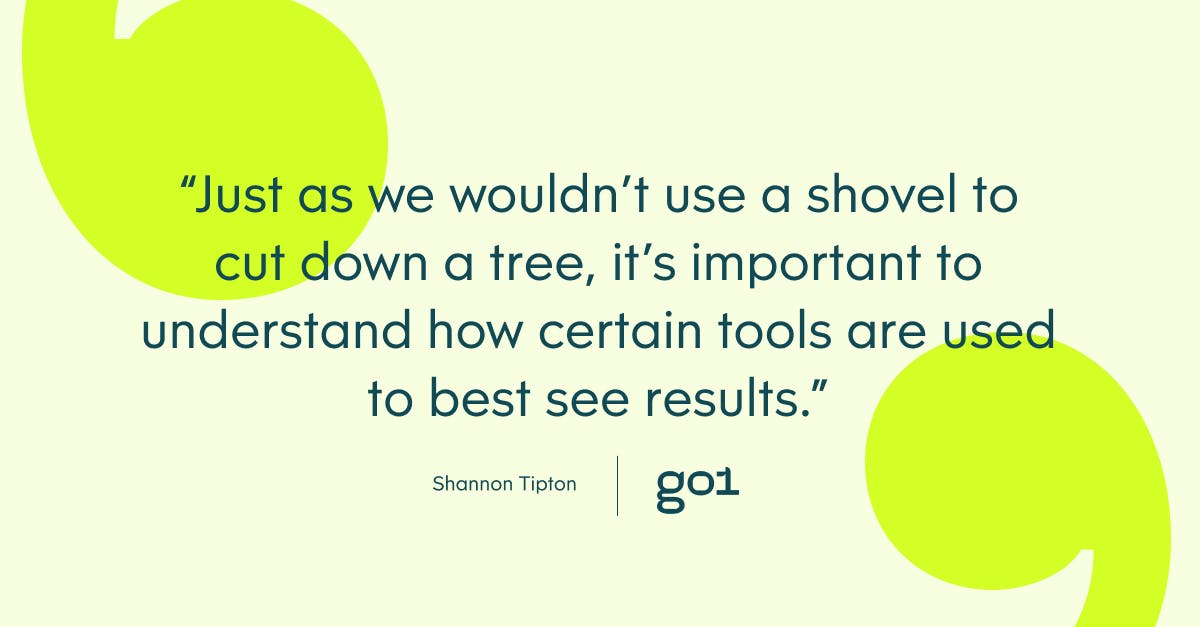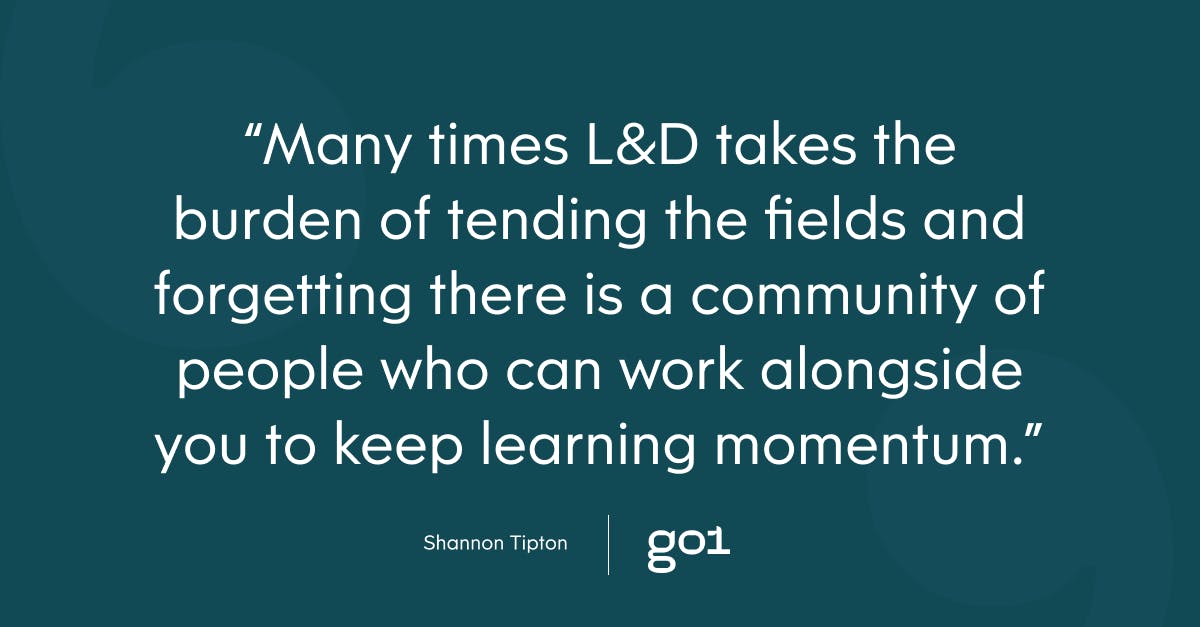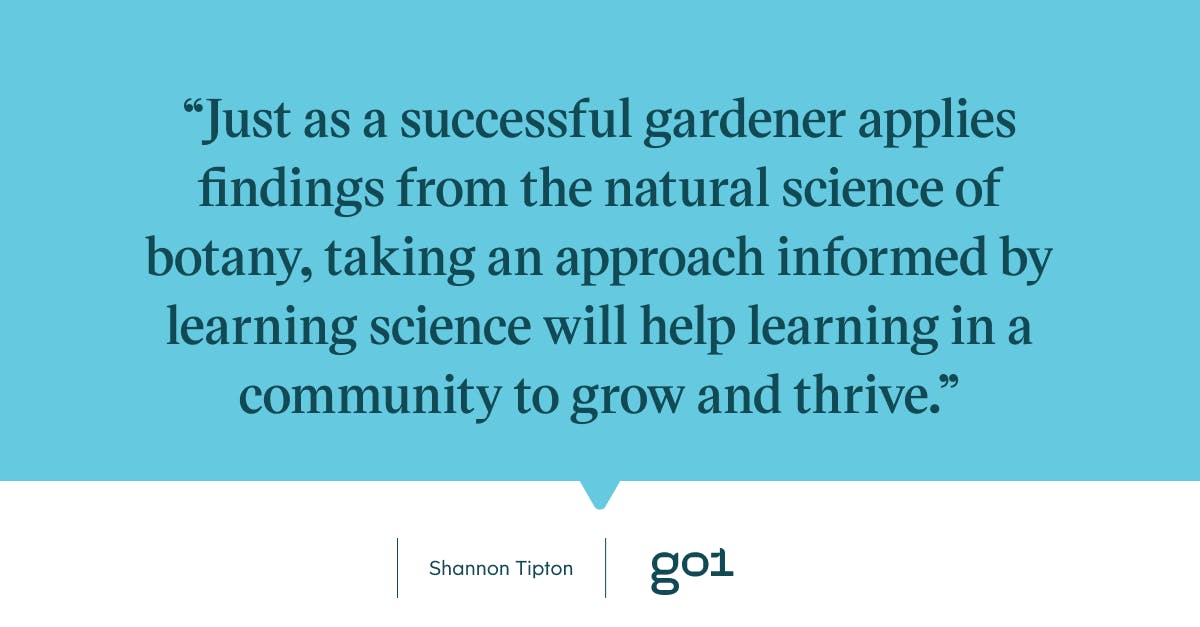
Enabling L&D to develop and nurture learning that delivers a rich harvest

Written by guest blogger Shannon Tipton. Chief Learning Officer of Learning Rebels LLC and co-founder of Emerging Stronger, Shannon's mission is to modernize, upgrade and reimagine workplace learning problems. She believes that by making complex training more interesting, engaging and impactful, training is transformed from being just another organizational event to becoming part of real business solutions.
Often when preparing to work on a project, we use the term: “right tool for the job”. But what does “right tool for the job” really mean? If you think carefully, this saying can take on a life of its own:
- Using a handy tool for a purpose for which it was never intended: Using a knife to dig a hole
- Using the right tool, but using it incorrectly: Using a watering can to water the grass in your front yard
- Using an incorrect tool but modifying that tool to try and imitate the performance of the correct item: Sharpening a shovel to try to cut down a tree as if it were an axe.
While using tools in this way may be clever or industrious, they are not really the “right tool for the job”. As the saying goes, when you have a hammer, everything looks like a nail. So what does it really mean when we talk about “right” tools to help us get a job done?
Just as we wouldn’t use a shovel to cut down a tree, it’s important to understand how certain tools are used to best see results.

Recently, Emerging Stronger team have created a series of tools to help you shape the ground for your learning and development (L&D) efforts:
- Needs Analysis Tool: To ensure you are planting L&D efforts in the right place
- Curation Decision Tool: That you are planting the correct plants in the right place
- Communication Plan Launch Tool: Making sure people know what we’ve planted and our plan for the harvest
- The Power Hour Tool: To share with the family how to maintain the garden
- Improve Impact Tool: To determine if this garden is worth planting again next season.
What is remaining is the tool to help keep your community garden growing strong. When thinking about how to best support learning in the workplace, many times L&D takes the burden of tending the fields and forgetting there is a community of people who can work alongside you to keep learning momentum.

Cultivating learning in workplace communities tool
It's no secret that workplace communities, when appropriately planned and nurtured, can create an environment for people to grow and develop as they work. Together sharing and learning to support performance and growth.
Just as a successful gardener applies findings from the natural science of botany, taking an approach informed by learning science will help learning in a community to grow and thrive.

Is this the right tool and is this the right time?
Are you just starting up your community, perhaps just beginning with a small plot of land and are looking for guidance as to what to grow and how? Have you started up your community of learners, and now need to keep it growing strong? Are you starting over because your community dried up? Are you looking to plant new seeds to add depth to your learning initiatives – then yes. Use this tool to cultivate learning, and:
- share relevant content to seed learning
- build and strengthen skills
- troubleshoot problems
- improve processes
- strengthen workplace practices or performance
Let your garden grow!
The purpose of this tool is to help create deliberate action to cultivate learning in workplace communities. As in most cases, one cannot simply drop seeds on hard ground and watch it grow into a delightful tomato patch. There are steps that need to be taken if you truly want to harvest the riches. With this in mind, the tool has been broken into six parts.
Part 1: Determine the purpose.
As with all things L&D related, “knowing the why” is not to be underestimated. If you are planning a butterfly garden, then planting a pine tree may not be helpful.
What is your work-related purpose for this community? Encourage people to take responsibility for their own continuous learning? Support people to learn from their work and each other? Improve performance through practice, reflection and collaboration? Or, perhaps build and sustain motivation through connection, accountability and progress. Knowing the endgame for the community allows you to start smarter.
Part one of this tool will help you determine the driving purpose of your community.
Part 2: Prepare.
Part of preparing to grow a garden is understanding and improving the growing conditions. The best tomato garden requires sun and rich soil. If what you have is hard clay and shade, and you are determined to grow tomatoes – then you must be prepared to do the hard work of amending the soil or your garden simply will not grow.
Part two of this tool will help you to ensure you have the right environment for your community to thrive.
Part 3: Sow.
Sowing simply means scattering seeds where they have the best chance to germinate. The sowing process in learning communities is the same. Throwing dirt on the ground and walking away hoping tomatoes will grow will lead to heartbreak. Seeding your community with relevant content, questions and activities will cause strong plants that support knowledge to grow.
Part three of this tool will show the many different formats and styles of “sowing” activities that can help learning grow.
Part 4: Nurture
Every garden needs regular maintenance, or it turns into a weed bed, dries up or becomes infested with pests. Knowing how to water, fertilise, weed and prune the garden is key for it to thrive. This same principles is applied with workplace communities. Leaving the community unattended and uncared for, will lead to negative results.
Part four of this tool will help to identify actions that can be taken to maintain healthy growing conditions to support learning in the community.
Part 5: Harvest
The ground has been prepared, seeds have been sowed and the garden has been cared for and nurtured. The garden has thrived and produced results. Now it’s time to gather and use the fruits of your careful labouring. What to do with 10 pounds of tomatoes? You’ve gone through all the labour it wouldn’t be right to let it all die on the vine.
Part five of this tool will help you to gather and use the knowledge and information harvested in the community.
Part 6: Garden Planning
Every good gardener keeps a garden journal. A journal gives a written record of the garden layouts, plant successes and failures. Allowing you to take note of plants and soil conditions so success can be repeated, and failures adjusted. This allows for proper planning. Good gardening techniques tell us to vary our approach, planting bulbs in the fall for spring or planting delicate herbs after the last frost. Keeping a calendar and planner will allow you to map how you will proceed.
Part 6 of this tool will allow you to plan your garden as it moves forward. Once you have planned how to prepare, sow, nurture and harvest – moving your plan to action becomes critical.
Download the Cultivating Learning in Workplace Communities tool now.
As the nursery rhyme goes: “Mary, Mary, quite contrary, how does your garden grow? With silver bells, and cockle shells, and so my garden grows.” And if you really want to know how to grow your garden, click here to download this step-by-step guide from Emerging Stronger developed for our publishing partner Go1.
This article is Part 3, the final in a series of blogs written by the Emerging Stronger team, each exploring the theme of workplace communities. Be sure to take a look at the other articles in the series, including:
- Part 1: Cultivating learning in workplace communities by Laura Overton
- Part 2: Applying learning science to workplace communities by Michelle Ockers
Want a step-by-step guide to cultivating learning in workplace communities? Download our latest toolkit from Emerging Stronger for insights on:
- Preparing the ground
- Sowing the right seeds to stimulate learning
- Nurturing growth
- Harvesting impact!




